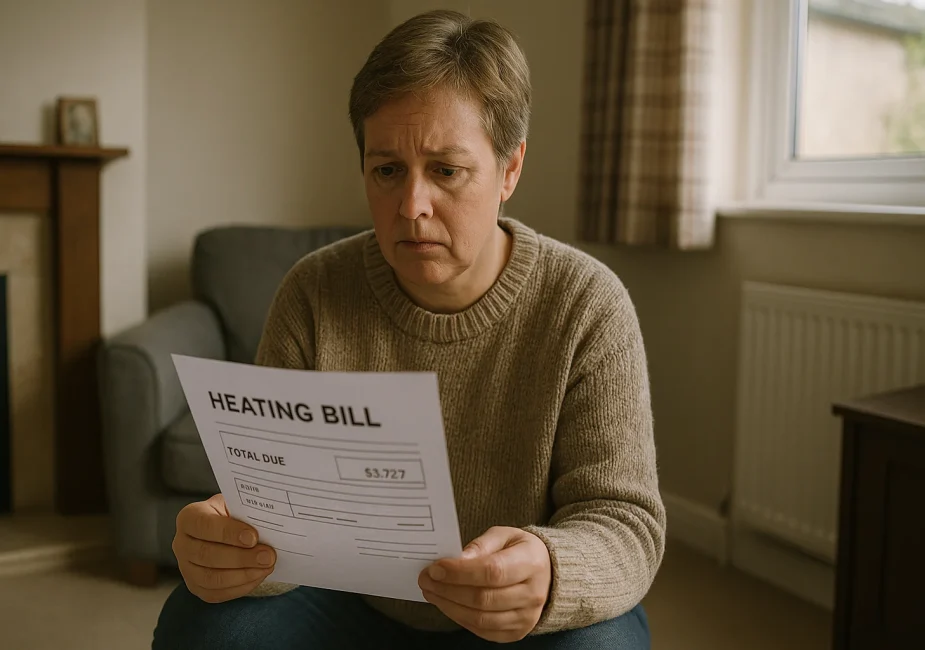£140 Cold Weather Payment – When Will It Be Paid?

As winter approaches and temperatures begin to plummet across the UK, many households start wondering about the financial support available to help cover rising heating costs. One question that often arises, when will the £140 cold weather payment be paid?”
The answer is slightly more complex than it first appears, as it blends aspects of two separate government-backed schemes, the Cold Weather Payment and the Warm Home Discount.
In this blog, we clarify what the Cold Weather Payment really entails, who qualifies, how the payments are triggered, and most importantly, when you can expect to receive it.
With rising energy prices and increasing financial pressure on vulnerable households, staying informed can make all the difference.
What Is the Cold Weather Payment and Is It Really £140?

There’s a common misconception that the Cold Weather Payment is a one-time £140 cash benefit. However, this isn’t accurate.
The Cold Weather Payment is actually a £25 payment issued for each 7-day period of exceptionally cold weather, where temperatures are recorded or forecasted to be 0°C or below.
The £140 (now £150) figure that often circulates during winter months typically refers to the Warm Home Discount, a completely separate support scheme applied to energy bills, not paid directly to individuals.
Understanding the difference between the two schemes is crucial:
| Scheme | Payment Amount | Type | Trigger | Paid To |
|---|---|---|---|---|
| Cold Weather Payment | £25 per 7-day cold spell | Multiple payments possible | Local temperatures ≤ 0°C for 7 days | Direct to bank account |
| Warm Home Discount | £150 (formerly £140) | One-off discount | Based on benefits/income | Applied to electricity bill |
These support mechanisms serve different purposes but are often received together by eligible households. The Cold Weather Payment offers direct financial relief during cold snaps, while the Warm Home Discount is applied to lower overall winter energy costs.
How Does the Cold Weather Payment Work in 2025/26?
Understanding how the Cold Weather Payment operates is essential for anyone relying on it to manage heating expenses during the harsh winter months.
The scheme is designed to offer direct cash support to eligible households when severe cold weather occurs, and it follows clearly defined criteria each year. For the 2025/26 winter season, the process remains similar to previous years but is updated with revised dates and eligibility standards.
Let’s explore how the system works in practice, how payments are triggered, and how often they might be issued.
What Triggers the Cold Weather Payment in the UK?
The Cold Weather Payment scheme for the 2025/26 winter season runs from 1 November 2025 to 31 March 2026. During this period, a £25 payment is automatically issued for each 7-day spell where the average daily temperature in a specific area is 0°C or lower.
Temperature data is collected from local weather stations, with each area mapped to a relevant station. If a cold spell occurs, the payment is automatically processed within 14 working days of the qualifying period ending.
How Often Can You Receive Cold Weather Payments in One Winter?
There is no maximum limit on how many Cold Weather Payments one can receive. If your area experiences multiple qualifying cold spells, you can receive multiple £25 payments throughout the winter.
The number of payments received depends on:
- The number of cold spells in your area
- Your benefit eligibility status during each qualifying week
- Whether your circumstances meet the additional qualifying conditions
In some years, certain postcodes have seen several payments issued, while others have had none, depending on local weather patterns.
Who Is Eligible for Cold Weather Payments in the UK?

Eligibility for Cold Weather Payments isn’t automatic for all benefit recipients. The scheme is targeted at people who are considered financially vulnerable, particularly those on means-tested benefits and in situations where the cost of staying warm could significantly impact their overall wellbeing.
To qualify, individuals or households must be receiving certain specific benefits, often with additional qualifying conditions. Below, we break down the eligibility criteria and how it applies to various types of claimants.
Do Universal Credit and Pension Credit Claimants Qualify?
Yes. If you’re on Pension Credit, you’ll generally receive Cold Weather Payments automatically. No extra action is required beyond continuing to receive your regular benefit.
If you receive Universal Credit, eligibility becomes slightly more complex. You may qualify if:
- You or your partner are not gainfully employed
- You have a child under the age of 5 living with you
- You or your partner have a disability or health condition with limited capability for work
- Your Universal Credit claim includes a disabled child amount
This payment system is designed to prioritise those who are most financially vulnerable and likely to face increased hardship due to energy costs in colder months.
Are Households with Children Under 5 Automatically Eligible?
Households with children under 5 may be eligible depending on their benefit status. For example, claimants of Income Support, income-based Jobseeker’s Allowance (JSA), or income-related Employment and Support Allowance (ESA) will qualify if a child under 5 resides in the home.
Eligibility Table:
| Benefit Type | Additional Conditions for Eligibility |
|---|---|
| Pension Credit | Automatically qualifies |
| Income Support / Income-based JSA | Must also have child under 5, disability or pensioner premium |
| Income-related ESA | Must be in support group or meet additional conditions |
| Universal Credit | Not working + health/disability or child under 5 |
| Support for Mortgage Interest (SMI) | Must meet additional criteria like disability or pensioner premium |
It’s also important to note that residents of Scotland are not eligible for Cold Weather Payments. Instead, they may receive the Winter Heating Payment, which is paid regardless of local temperatures.
When Will Cold Weather Payments Be Made This Winter?
The Cold Weather Payment scheme is active from 1 November to 31 March each year. If your area experiences a qualifying cold spell during this window, the Department for Work and Pensions (DWP) will issue your £25 payment within 14 working days.
You don’t need to apply. Payments are made automatically to the same bank account into which your benefits are paid.
This timeline ensures that support is delivered promptly to those most in need, especially in periods of extreme weather. However, delays can occur if your circumstances have recently changed or if your benefit record requires an update.
How Can You Check If a Cold Weather Payment Is Due in Your Area?

The UK government provides a Cold Weather Payment postcode checker, available on its official website during the winter months. This tool allows you to input your postcode and see whether a qualifying cold spell has occurred in your region.
The checker uses data from local Met Office weather stations and updates regularly. Each area is linked to one of the 95 weather stations across the UK, ensuring geographically relevant information.
Here’s a simplified breakdown of the process:
| Step | Action |
|---|---|
| 1 | Visit the postcode checker online |
| 2 | Enter your postcode |
| 3 | View the result showing recent cold spell data |
| 4 | Check your bank account for payment after 14 working days if eligible |
Checking the tool frequently during cold snaps can help you stay informed about payment expectations.
What Is the Difference Between the Cold Weather Payment and the Warm Home Discount?
The key difference between these two schemes lies in their payment structure and purpose.
The Cold Weather Payment is a direct cash payment based on local weather conditions. In contrast, the Warm Home Discount is a one-time credit applied to your electricity bill, typically by the end of March each year.
Key distinctions:
| Feature | Cold Weather Payment | Warm Home Discount |
|---|---|---|
| Amount | £25 per qualifying period | £150 one-time |
| Payment Type | Direct cash | Energy bill credit |
| Trigger | Local temperatures | Household income/benefits |
| Frequency | Multiple per winter | Once per winter |
| Application Needed? | No | Usually no (auto-applied) |
The Warm Home Discount has increased from £140 to £150 for the 2025/26 winter season. It’s important not to confuse this figure with the Cold Weather Payment.
Can You Receive Both the Cold Weather Payment and the Warm Home Discount?
Yes, eligible households can receive both the Cold Weather Payment and the Warm Home Discount. These schemes are not mutually exclusive and often overlap for households receiving certain benefits like Pension Credit or Universal Credit.
Receiving both can significantly reduce your winter heating costs, offering both upfront bill reductions and cash support during extreme weather.
Many households in low-income brackets rely on both schemes to stay warm and financially secure throughout the colder months.
What Should You Do If You Haven’t Received a Cold Weather Payment?

While the system is designed to be automatic, issues can occasionally arise. If you haven’t received a payment after a known cold spell, there are a few steps to take:
Should You Contact the DWP or Universal Credit Helpline?
If you’re on Universal Credit, the best first step is to log into your online account and add a note to your journal explaining the issue. If you don’t have online access, call the Universal Credit helpline.
For those receiving other qualifying benefits, contact your Jobcentre Plus or the Pension Service directly to report the missing payment.
Can Personal Circumstances Like Hospitalisation Delay the Payment?
Yes. In certain situations, such as a hospital stay or a change in household composition (like having a baby or a child under 5 move in), the DWP may not be automatically notified. You must inform the relevant authority to ensure your records reflect your updated situation.
What Other Winter Heating Support Is Available for Low-Income Households?
Winter energy costs can be a heavy burden, especially for low-income households. Fortunately, there are several support schemes designed to help ease the pressure and keep homes warm during the colder months.
Key Support Schemes to Explore
- Winter Fuel Payment: Available for those over State Pension age, ranging from £100 to £300 depending on age and household circumstances.
- Energy Price Guarantee: Caps the price per unit of energy, helping protect against sharp increases in bills.
- Household Support Fund: Managed by local councils, this fund offers emergency help through direct payments or vouchers for vulnerable households.
- Energy Supplier Grants: Many energy suppliers offer hardship funds or grants for customers struggling to pay their bills.
By exploring these schemes, households can access financial support to stay warm and manage energy costs effectively. Taking advantage of available assistance ensures a safer and more comfortable winter
Conclusion
While many people mistakenly refer to a £140 Cold Weather Payment, the true support system includes a £25 cash payment for every cold spell and a £150 Warm Home Discount applied to energy bills.
Knowing the difference, and understanding how and when these payments are made, is key to ensuring your household receives the support it’s entitled to.
If you’re receiving qualifying benefits, keep your personal details updated, monitor local temperatures, and use the government’s postcode checker to stay informed.
With multiple schemes working in tandem, the UK government provides a range of financial safety nets to help keep homes warm through the coldest months of the year.
Frequently Asked Questions
How Is the Cold Weather Payment Funded by the Government?
The Cold Weather Payment is funded by the UK government through the Department for Work and Pensions (DWP) as part of its social welfare programme to support vulnerable households during winter.
Does the Cold Weather Payment Affect Other Benefit Entitlements?
No, receiving a Cold Weather Payment does not reduce or interfere with your other benefits. It is treated as a separate, non-taxable support payment.
Are People Living in Scotland Eligible for Cold Weather Payments?
No, residents of Scotland receive a different scheme known as the Winter Heating Payment, which is paid regardless of local weather conditions.
Can You Get Cold Weather Payment if You Use a Prepaid Energy Meter?
Yes. Your energy payment method doesn’t affect your eligibility. The payment is made into your benefit account, not through your energy supplier.
What Happens If You Change Your Address During the Cold Weather Payment Period?
If you move, your eligibility depends on the weather in your new postcode. Be sure to update your details with DWP to avoid delays.
Is There a Deadline for Receiving the Cold Weather Payment?
Payments are made within 14 working days of a qualifying cold spell. As long as the event occurs within the 1 November – 31 March window, you’re eligible.
What Is the Role of the Met Office in Cold Weather Payment Decisions?
The Met Office provides the temperature data used to determine whether a cold spell has occurred in your area. Their readings trigger the payment process.



